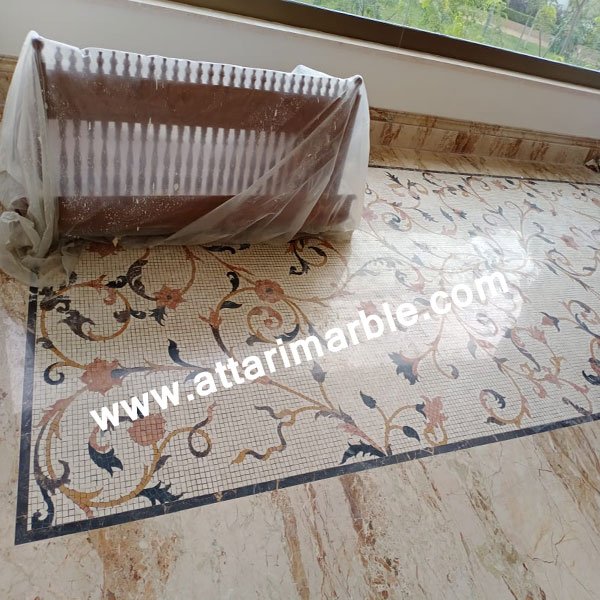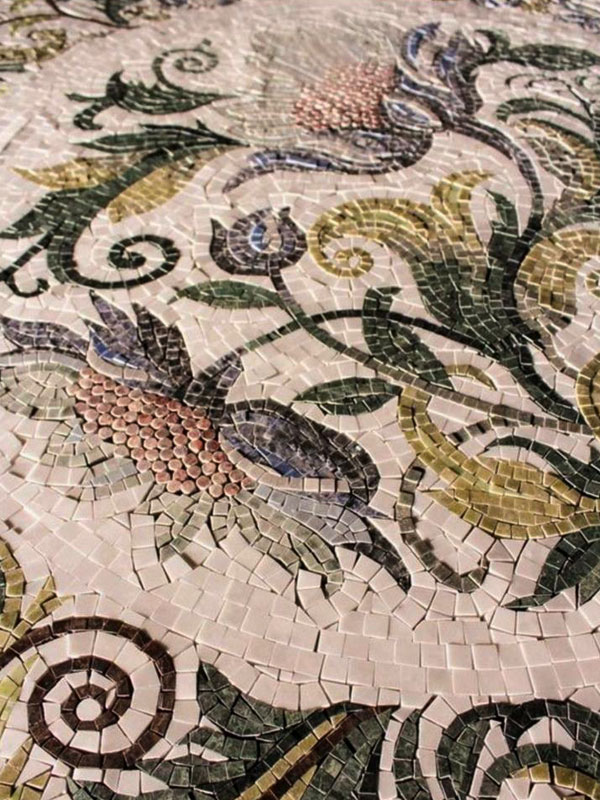The Many Different Mosaic Materials & Types of Tesserae
Mosaic art is an ancient practice that has evolved into a modern design trend, adding texture, color, and depth to various spaces. The essence of mosaic art lies in its building blocks—tesserae. These small pieces can be made from a variety of materials, each contributing to the final design’s aesthetic and durability. Below, we’ll explore the different materials used in creating tesserae and how these materials are influencing modern interior design trends.



1. Glass Tesserae
Glass is one of the most popular materials used in mosaic art due to its vibrant colors and reflective properties. Glass tesserae can be made from smalti (hand-cut, opaque glass) or vitreous glass, both offering a range of color
options that do not fade over time. They are often used in creating intricate patterns and images because of their ability to catch and reflect light, making them ideal for both indoor and outdoor use.
2. Ceramic Tesserae
Ceramic tesserae are made from glazed or unglazed fired clay. They offer a durable and versatile option for mosaics, available in various colors and finishes. Ceramic tesserae are often used for flooring, kitchen backsplashes, and bathroom walls due to their water resistance and easy maintenance. They can be shaped into different forms, allowing for more complex and detailed designs.
3. Stone Tesserae
Stone tesserae are typically made from natural stones such as marble, granite, or travertine. These materials give mosaics a timeless and earthy quality, often used in more traditional or rustic designs. The natural variation in
color and texture found in stone tesserae adds depth and richness to the mosaic. Stone is particularly popular in flooring and wall accents, where its durability can be showcased.
4. Metal Tesserae
Metal tesserae, made from materials such as stainless steel, copper, or brass, add a modern and industrial touch to mosaics. These pieces are usually used as accents within a larger mosaic to add a touch of sophistication and shine. Metal tesserae are resistant to wear and tear, making them suitable for high-traffic areas and exterior designs.
5. Shell Tesserae
Shell tesserae, often made from mother-of-pearl or other natural shells, provide an iridescent finish that is both luxurious and delicate. These tesserae are typically used in decorative elements rather than functional surfaces due to their fragility. Shell tesserae bring a touch of nature and elegance to mosaic designs, making them ideal for adding subtle highlights.
Mosaic Materials in Modern Interior Designs
In modern interior design, mosaics are not just limited to floors or walls. Designers are increasingly using them in innovative ways, incorporating different materials to create unique and personalized spaces. Here’s how various mosaic materials are making an impact:
● Accent Walls and Backsplashes: Glass and ceramic tesserae are often used to create stunning accent walls and backsplashes in kitchens and bathrooms. The reflective quality of glass can make small spaces appear larger and brighter, while ceramic provides durability and ease of cleaning.
● Flooring: Stone tesserae are ideal for flooring due to their strength and longevity. They are often used in entryways, bathrooms, and outdoor patios, where their natural texture adds a sophisticated touch to the design.
● Furniture Inlays: Metal and shell tesserae are being used creatively in furniture inlays, adding a touch of luxury and detail to coffee tables, cabinets, and even headboards. These materials can transform ordinary furniture into statement pieces.
● Murals and Artwork: Modern mosaics are not just functional but also artistic. Designers are using a combination of glass, stone, and shell tesserae to create custom murals and artwork that serve as focal points in living rooms, hallways, and lobbies.

The Future of Mosaic in Home Decor
Sustainability in interior design is making mosaics change direction towards recycled, earth-friendly materials. Recycled glass, ceramic bits are being used in some works, providing an attractive, yet sustainable alternative. Tech progress could usher in more complex patterns, thanks to finely-cut mosaic pieces. This opens up more room for creativity with mosaic art. Having mosaics in updated interior design adds beauty, plus a chancefor personal,
one-of-a-kind expressions in our homes. As we get moreadvanced materials and techniques, mosaics will always be a classic, adaptable part of home styling, forming thefuture’s spaces.

